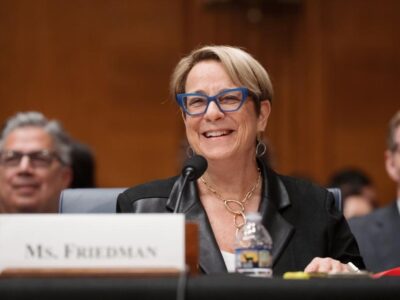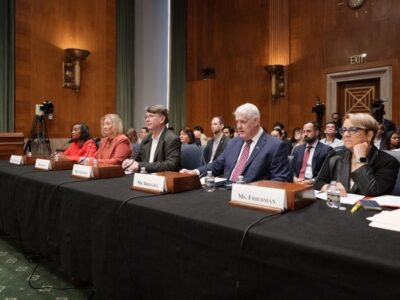
MarketWatch: Could your employer take away your 401(k) match? Sherwin-Williams just did it.
For countless American workers, the 401(k) company match is simply a fact of life: They contribute regularly to their employer-sponsored retirement plan — and in turn, the employer kicks in a matching amount. The average company contribution equates to 4.6% of a worker’s pay, according to Vanguard. But what if that match just disappears?

It’s Time to Celebrate Social Security’s Birthday
By David Brandolph Let’s all raise a glass in honor of Social Security, the nation’s most successful social insurance program, as it celebrates its 90th anniversary. On August 14, 1935, America was mired in the Great Depression with roughly one-half of our nation’s elderly living in poverty. On that day, precisely 90 years ago, President […]

PRC Executive Director Testifies on Retirement Income Solutions
Karen Friedman, the Pension Rights Center’s Executive Director, recently testified before the U.S. Senate’s Committee on Health, Education, Labor and Pensions (HELP) on expanding coverage for the millions of private sector workers not covered by or participating in an employer-sponsored retirement benefit plan. Karen’s goal was to make the Senators aware that retirement insecurity is […]

PRC’s Written Testimony to the Senate HELP Committee
Written testimony provided to the Senate Committee on Health, Education, Labor, and Pensions by Karen Friedman on behalf of the Pension Rights Center. Friedman testified before the Committee on July 17, 2025 to urge Congress to take steps to improve the retirement income security of American workers.

PRC Calls on Congress to Enhance Retirees’ Financial Security
Pension Rights Center (PRC) Executive Director Karen Friedman testified before the Senate Health Education, Labor and Pension (HELP) Committee during a July 17th hearing entitled “Freedom to Work: Unlocking Benefits for Independent Workers.” Friedman told members of the Committee that they must act to address Americans’ justifiable fear of having insufficient resources and income to […]

Retaining Employment Records Can Be Crucial
Everyone Makes Mistakes It’s a fact of life: everyone makes mistakes—including retirement plan administrators. Mistakes are especially likely to occur when employers change recordkeepers or systems of keeping records. Retaining your own records of employment can mean that those mistakes can be corrected. Changes for Federal Workers The recent announcement from the Office of Personnel […]

Widow Wins “Benefits” – but From an Unexpected Source
One of the PRC’s favorite slogans is “persistence pays off.” And that strategy sure paid off for 73-year-old Elaine Silverberg who—after fighting for 13 years to get the widow’s benefits she believed she was owed from her late husband’s pension plan—finally received the money. Just not from the pension plan. While her late husband’s pension […]

PRC Welcomes New Additions
Spring is in the air, and consistent with the upcoming season of growth and renewal, the Pension Rights Center is excited to welcome four additions to our team: a new legal director and three new members of our Board of Directors. Theresa (Tess) S. Gee, PRC’s new legal director, has wide-ranging experience with retirement issues […]

DOL Introduces Lost and Found Database
By Jane Smith Looking for your retirement benefits from a former employer? The Department of Labor has developed a searchable online database that may make it easier for former employees to find their earned benefits. The Retirement Savings Lost and Found Database is a resource for employees who separated from employment and still have earned retirement […]

Saving Paper Copy Pays Off for Pension Counseling Project Client
A recent victory by the Trellis Project—Mid America Region demonstrates how important retaining paper copies of plan documents can be. In this case, John, a 79-year-old former employee of a large corporation, contacted Trellis because he was denied pension benefits. The corporation and its plan said there was no record of his employment — even […]



